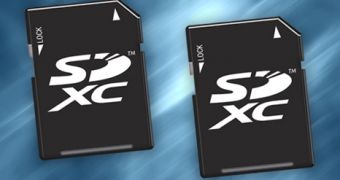The SDXC (Secure Digital Extended Capacity), showcased at CES 2009 back in January, is a type of memory that has a maximum data capacity of 2TB. Although, currently, the data transfer speed is only 104MB/s, future models are expected to boast speeds of 300MB/s.
Considering the advancements in all other aspects of notebooks, including graphics, storage, display, memory and processing power (the upcoming core i3, i5 and i7 processors), notebook designers seem to be interested in upgrading the Secure Digital card readers as well, in order to fully utilize the new technology's resources.
The SDXC reader is backward compatible, able to read SDHC, SD, and MMC memory cards. However, even at the current transfer possibilities of 104MB/s, read and write speeds are limited by the ability of USB 2.0, which means that designers may need to renounce this interface and try to somehow use the PCI Express bus that can support the fresh cards' bandwidth. This adds a certain difficulty to implementing the SDXC into notebooks, but companies like Lenovo, HP, and Dell are already supposedly working on SDXC-supporting laptops.
The new notebooks are expected to debut, along with most IT entries, at the 2010 Consumer Electronics Show in January. Intel's fresh CPUs will also be coming out soon, namely Core i3, i5 and i7, including the 32nm Arrandale central processor. These central processing units will provide excellent support for the large bandwidth of the SDXC with their increased processing power and low power consumption.
Other companies besides Dell, Lenovo and HP have not made any statement regarding whether or not they are going to do anything about SDXC in the near future, but Apple's iMac and MacBook Pro already boast SD (currently SDHC). This means that Apple might be one of the later entries, despite the fact that the two products were updated rather recently.

 14 DAY TRIAL //
14 DAY TRIAL //